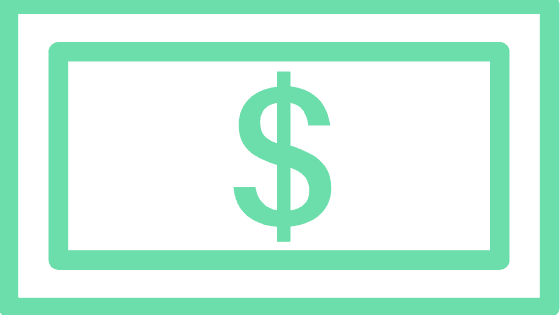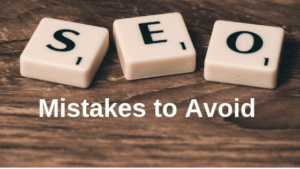You’re skeptical.
You hear about bloggers who learned how to start a blog and now make money while they sleep — bloggers who seem to always be on vacation or spend all their time with their families, and somehow still make a sh*it load of money.
It sounds too good to be true. Especially when you’re working hard every day and can barely make ends meet.
But it’s not a myth. Once your blog gains a steady amount of traffic, you can turn it into a passive income machine. You’ll make money on autopilot and best of all will not have to resort to any shady tactics to do so.
However, before you can make money from your blog you must do the following three things:
#1. Start a Blog
You can dream all you want about becoming a full-time blogger and traveling the world while flying on a private jet, but none of that will be possible unless you start your blog.
When aspiring bloggers ask me about starting a profitable blog I always recommend them to start a self-host WordPress blog with Bluehost.
You can take advantage of Bluehost’s high quality hosting for less than $4 per month and get a free domain name (blog name) to boot ($10 savings).
Useful resources:
#2. Create Epic Content
So now that you have built your blog you are ready to create some epic blog posts for your readers.
The reason why this section is called “Create Epic Content” is that your blog posts really need to stand out.
There are over 4 million blog posts published every day and with so much competition you need to make sure you’re creating epic content in order to stand out from the rest.
You must create content that people want to read, engage with, and share.
Make sure your blog posts are:
- At least 1,500 words
- Well written
- Contain visually appealing images
- Well researched
- Contain links to other posts in yours and other blogs
Useful resources:
#3. Promote it
I promise you this… No matter how great your articles are no one is going to know about them unless you take time to promote them.
It’s not possible to make money from your blog if you don’t promote it.
You could create bad content and still make money from your blog if you do a good job promoting it. However, it doesn’t work the other way around.
Note: In order to get the most out of your promotional efforts, you should focus on creating epic content.
How you choose to promote your blog is up to you.
Some people like using social media, while others like spreading the word through influencers and emails.
I personally like mixing it all up — some social media, contacting everyone I know through email, and using influencers to spread the word.
Useful resources:
Now that you know the three things you must do before you start to make money from your blog, lets the best ways to actually make money from your blog.
9 Ways To Make a Sh*t Load of Money from Your Blog
#1. Affiliate Marketing
Just in case you’re wondering what exactly is affiliate marketing?
Quite simply, affiliate marketing is the process of earning a commission for promoting other people’s (or company’s) products or services.
The way it works is you find a product you like, promote it to your readers, and earn a portion of the profit from each sale that you generate.
In essence, you’re making money by sharing, recommending, and promoting another person’s products or services.
In other words, you generate an income by helping others sell their products.
The best part about affiliate marketing and the reason why it’s my favorite way of making money from my blog is that you don’t have to create your own products.
No need to invest your time and effort to create something to sell.
Example: I host this blog on Bluehost. Because I like their service so much I decided to partner up with them to provide you with a great deal on their hosting services. They provided me with this unique link that tracks all the clicks and purchases made by my readers. Once you make a purchase, I get a commission at no additional cost to you.
I believe the key to being successful at making money from your blog through affiliate marketing is to only recommend products that you use and truly believe in.
It’s easy to recommend a bunch of different products just to make a quick buck, but I think most people can tell when someone is promoting a product just to make money.
Example: I love using Canva to edit graphics and Pixabay for finding free stock photos to use on my blog posts. They both have paid versions of their services, but I don’t use them so I recommend their free services instead.
So now you know how affiliate marketing works.
Now let’s look at some of the most popular affiliate marketing sites.
Amazon Associates
Everybody knows Amazon. They are the largest online retailer in the world.
Joining their affiliate program allows you to make a commission on any product sold on their website.
And with over 600 million products to choose from, I am sure you can find one to your liking.
The only downside that I can think of for those of you considering to become an Amazon Associate is that their commissions tend to be on the low side.
However, because they are Amazon, their conversion rates are high so it probably balances itself out.
ShareASale
ShareASale is a marketplace that houses merchants who don’t want to run their affiliate marketing programs in-house.
In other words, they provide their clients with a way to have an affiliate marketing program without having to worry about tracking sales or managing affiliates.
They are great for bloggers because they provide you with thousands of affiliate marketing programs that you can join in one place.
Put another way… the ShareASale network brings merchants and affiliates together.
eBay Partners
Everyone remembers eBay as the website where you could literally have your own garage sale in front of the entire world.
These days, eBay is more geared towards businesses and not so much towards people trying to sell their unwanted goods.
However, this does not mean that you couldn’t get in on the action.
Joining eBay Partners allows you to make a commission on any product that your readers buy on their website.
Similar to Amazon, their commissions tend to be low, but because everyone trusts their website the conversions tend to be high.
Also, just like Amazon, you make money on any purchase that a person you refer to makes on their website within a given amount of time. Regardless of whether it’s the product you referred them to or not.
Clickbank
Clickbank is a large affiliate marketing network that works similarly to ShareASale.
The main difference being that Clickbank’s focus is on digital information products.
They provide affiliates with over 50 thousand unique products to choose from to promote on their blogs.
Since its inception Clickbank has generated over $3 billion in sales, so give them a look.
Shopify
Shopify is a Canadian based e-commerce platform that lets you start, grow, and manage a business.
There are over 800,000 different vendors on their platform and just last year their sales exceeded $41 billion.
Becoming a Shopify partner is easy and allows you to earn a commission on every new member you send their way.
Note: With Shopify, you won’t make money on what people buy on their platform. You take a one-time commission when people sign-up for their services.
Google Trick
If you decide to become an affiliate marketer it’s almost impossible not to find a program that suits your needs from the options above.
However, one of my favorite ways to find affiliate marketing opportunities is by using Google.
Run the following Google search: “company + affiliate program.”
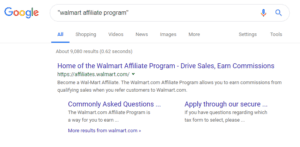
This helps you in finding companies that run their own affiliate programs.
Another way to find these unlisted affiliate programs is to analyze your competitors’ blogs and see if they’re promoting products that are not listed in any of the networks mentioned above.
Useful resources:
#2. Blog Ads
I dislike blog ads but I cannot deny their popularity among bloggers.
I don’t blame them either — research shows that digital ad spend will hit $129.34 billion in 2019 and grow to over $172 billion by 2021.
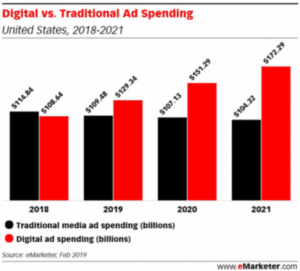
Those are staggering numbers and I won’t get in your way if you want to get a piece of that pie.
There’s just no denying that displaying ads is a viable way to make money from your blog.
So let’s talk about how you can get paid with this method.
Blog ads pay you in several different ways:
- Pay-per-click (PPC): You get paid a set amount when people click on the ad.
- Cost per Impression (CPM): You get paid based on 1,000 impressions of the ad.
- Cost per action (CPA): Payment is based on a specific action caused by the ad.
Your blog’s traffic will greatly influence the rates you will receive from companies that want to display their ads on your blog.
Another factor is how targeted your audience is. The more targeted and engaged your audience is, the higher the rates you’ll be able to charge.
Note: Because traffic is so important to making money from blog ads, it is not the best option for beginners.
You’d be hard-pressed to make $100 a month from blog ads if you have under 20 thousand monthly visitors.
That being said, you can make some serious dough once your blog traffic hits certain levels.
Now you’re probably wondering what are the best blog ad networks to join.
So let’s take a look at some of the most popular ad networks:
Google AdSense
By far the largest ad network in the world.
Google AdSense allows publishers (you) to display their ads and make 68% of the revenue they earn from advertisers for displaying the ad on your site.
Joining the Google AdSense program is free for any blogger that meets their guidelines.
They don’t require a minimum amount of traffic, so if your blog isn’t spammy you’re bound to be accepted.
Below is a list of the types of ads you can choose from:
- Text
- Image
- Rich media
- Flash
- Video
- Animated image
- Audio
- Links
Because of Google AdSense popularity among advertisers, you won’t have a hard time finding a good mix of ad types to choose from regardless of your niche.
Payment Methods: Check, direct deposit, electronic funds, or Western Union.
Payment Terms: Net-30.
Minimum Payout Threshold: $100
Propeller Ads
Founded in 2011, Propeller Ads has quickly grown into one of the largest ad networks in the world.
Below are some numbers you should know about this company:

As with AdSense, Propeller Ads doesn’t require a minimum amount of traffic to join their network so long as your blog meets their relaxed guidelines.
Below is a list of the types of ads you can choose from:
- Onclick or Popunders (full-tab ads)
- Dialogs
- interstitial (displayed before or after content)
- Banners
- Direct links
- Sliders
To my knowledge, they have yet to integrate video ads to their network.
That being said, Propeller Ads, is compatible with AdSense so you can combine the two to get the best of both worlds.
Note: Most ad networks frown upon your usage of other ad networks ads.
Payment Methods: Paypal, Skrill, Payoneer, ePayments, WebMoney, and direct deposit.
Payment Terms: Weekly (every Thursday).
Minimum Payout Threshold: As low as $5.
Mediavine
Mediavine is a full-service ad management company.
This means that when you sign up for their services, they control what ads display on your blog.
Below are some numbers you should know about this company:
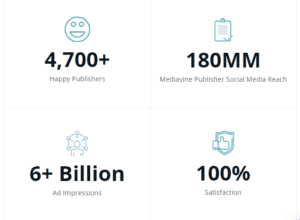
Joining Mediavine is a bit different than the ad networks mentioned above.
For one, your blog is required to have a minimum of 25,000 sessions a month which they verify through Google Analytics.
And secondly, even if you meet the above requirement, they can deny you if they don’t feel like your blog can add value to their partners.
Remember… they are going to manage the ads on your blog, so it’s in their best interest that your blog performs well.
Therefore, if they don’t feel like your blog will generate enough clicks, they will reject you even if you exceed their traffic requirements.
That might sound harsh and you might be scared away, but on the contrary, that should make you want to join them.
Mediavine maximizes your earning potential by placing ads that they know will perform well on your blog.
Think about it… they are managing your ads and the only way for both of you to make money is to generate revenues for their partners.
You are practically allowing an expert to manage your ad campaign and pay you for it.
I have yet to run hear anyone saying that their earnings diminished by switching from Adsense to Mediavine.
Payment Methods: Check, PayPal, and direct deposit.
Payment Terms: Net-65.
Minimum Payout Threshold: As low as $25.
AdThrive
AdThrive was founded in 2013 as a full-service ad management company.
Similarly to Mediavine, when you sign up for their services you give up total control of your ad space to them.
The main difference between the two companies is that AdThrive requires that your blog have a minimum of 100,000 monthly page views instead of 25,000.
Outside of ad management their services include the following:
- Video Monetization
- Publisher dashboard
- Learning tools
- Opportunities to grow your traffic
- Expert support and guidance from their team of pros
The reasons for joining AdThrive as opposed to Google AdSense are the same as Mediavine.
However, AdThrive claims that sites coming from competing ad management services average 68% more revenue per pageview.
I have no way of confirming that claim, but bloggers such as Cheryl seem to agree.
Payment Methods: Check, PayPal, and direct deposit.
Payment Terms: Net-45.
Minimum Payout Threshold: As low as $25.
Sell Your Own
Don’t feel like working for Google or giving up control of your blog’s ad space?
Then you should look into selling your own ad space as a way to make money from your blog.
This way you are not splitting fees with anyone. Why pay someone else for your hard work?
The only downside to selling your own ad space is that you have to find advertisers that are willing to pay to place their ads on your blog yourself.
That might sound like a scary thing to do but it’s not.
You already have an absurd amount of knowledge of the market that you’re in, so use it to your advantage.
Spy on your competitors and find out what products and services they’re promoting.
Contact those companies to tell them about your blog and ask them if they’d like to advertise on your blog.
If you know of companies that aren’t advertising anywhere which you feel could benefit from advertising on your blog contact them as well.
See the resources useful resources section to get an idea of how much you should charge for ad space in your blog.
Note: I firmly believe that you can get more bang for your buck using the other methods mentioned in this blog for making money from your blog.
Useful resources:
#3. Freelancing (Selling Your Services)
If you’re a new blogger who wants to make money from your blog now. Selling your services is the easiest way to do so.
It doesn’t require much traffic as long as your sales pitch is good enough.
What services can you offer?
- Writing
- Web design
- Photography
- Video creation
- Website analysis
- Marketing
- Developing
- Editing
- Social media management
- Virtual assistance
- Translation
- SEO
- Paid advertising campaigns
- Project management
- Product sourcing
- Tax preparation
- Coaching
- Consultant
I’ll stop there, but it’s completely up to you as to what services you’d like to offer.
There are three things you must do if you want to succeed as a freelancer:
- Create an enticing about me page.
- Create a page called “Hire Me” or “Work With Me.”
- Have an amazing sales pitch.
To create pages on your WordPress blog, please follow the instructions on section 5 of my guide on how to start a blog and make money.
Once you do that, you must create an amazing sales pitch.
Remember that you’re just starting out so your traffic won’t be large enough to make money with an ordinary sales pitch.
No to mention that no one will know you unless you happen to be a popular figure in your niche.
If possible, include examples and testimonials in your sales pitch.
Useful resources:
#4. Physical Products
When you think of selling physical products on your blog, it might seem like a nightmare.
You imagine yourself creating the product in your garage and being surrounded by a bunch of empty boxes waiting to be filled with the orders that come in.
But what if you created a product that your readers couldn’t get enough of?
How would you feel?
You’d probably jump in celebration and start planning to hire your first employee.
The key to being successful in selling physical products on your blog is to know your audience and creating a product that fulfills their needs.
I can’t stress that enough. You shouldn’t bother creating a product if you can’t describe your audience.
Now let’s take a look at some of the advantages and disadvantages of creating your own physical products.
Advantages
- Complete control of inventory.
- Pricing is up to you.
- Modifications can be made at any time based on feedback.
Disadvantages:
- Need space for inventory.
- Completely dependant on you.
- You have to wear a lot of hats.
Don’t have space or time required to sell physical products on your blog?
Try dropshipping!
Dropshipping is the act of selling a physical product on your blog that is created and stored by someone else.
In other words, you take the order and forward it to your drop-shipper.
They create the product, store it, fulfill your orders, and ship out to your clients.
Nerdfitness is a great example of a company making use of a drop shipper to fulfill its orders.
Up to you as to which form of selling physical products you prefer.
No matter which one you choose, if done correctly you will certainly make money from your blog selling physical products.
Useful resources:
#5. Sponsored Blog Posts
Blogging is all about building a relationship with your audience and leveraging that relationship to make money.
Sponsored blog posts are a way for brands and companies to partner with influencers (you) to promote and market their products and services for a fee.
The fees you charge these companies are up to you. However, they normally depend on audience size, relevance, and engagement levels.
Some bloggers charge thousands for a single sponsored post, but starting out you shouldn’t expect to make that kind of money.
If you wish to explore the usage of sponsored blog posts as a way to make money from your blog, you should probably consider looking into sponsored post networks.
Sponsored post networks to consider:
- IZEA
- TapInfluence
- Weave Meade Made Media
- Social Fabric
- Activate by Bloglovin’ (formerly Swerve)
- Influence Central
- One2One Network
- Pollinate Media
- Real Clever (formerly Clever Girls)
- Social Stars
- Sway Group
Sponsored post networks work hard to connect publishers (you) and sponsors.
They are a great way to get your feet wet when you’re first starting out.
However, as your blog traffic grows you will have brands and companies contacting you about sponsoring your content.
And even if they don’t, as your traffic grows, you can start contacting companies within your niche about possibly sponsoring your blog posts.
Useful resources:
#6. Online Courses and Workshops
Everyone using the internet nowadays is used to seeing courses and workshops being offered online.
Bloggers offer courses and workshops on just about anything you can think of.
Why you might ask?
Simple, because they work!
Online courses and workshops are a great way of monetizing your blog.
You can offer them in the form of videos or written content.
The beauty of selling online courses and workshops is that you create them once and sell them forever.
Note: I suggest updating them with new information occasionally.
This will ensure that your buyers are receiving the most up-to-date information on the subject.
A huge benefit of creating an online course or workshop is that you can sell them even if your blog has no traffic.
You can do this through the use of online course platforms that allow you to sell them for a fee.
Online course platforms to consider:
Whatever you blog about can be turned into an online course. It’s simply up to you if this is the route you’d like to take for monetizing your blog.
Useful Resources:
#7. Digital Products
A digital product is an intangible asset or piece of media that can be sold and distributed repeatedly online without the need to replenish inventory.
Similarly to online courses, you create them once and can sell them forever.
Benefits of selling digital products on your blog include:
- Scalability – No limits on how much product you can sell.
- Logistics – There are none.
- Costs – Outside of your time, monetary costs are low.
Digital products come in many forms and sizes.
Below are some types of digital products:
- Ebook
- Templates
- Research
- Audio
- Video
- Photos
- Recordings
- Designs
- Apps
- Games
- Codes
This list only scratches the surface.
Two questions you must ponder when creating digital products:
#1. What to sell
This is a hard question for me to help you answer because it completely depends on your expertise.
However, I’ll try to help you find the answer.
First, I need you to write down what your blog is about.
Second, make a list of 10 things you must blog about.
Example: I created this blog to help people learn how to start a blog, grow its traffic, and make money. Therefore I know that I must blog about starting a blog, designing it, promoting it, and monetizing it. From there I should be able to pick a topic that I can create a digital product around.
#2. How to sell it
Now that you know what to sell, the question becomes how to sell it.
If your blog is in its infancy it’s probably not the best place to sell if you wish to start generating an income from your creation.
Instead, you can sell your digital products through these networks:
You could also try better-known companies such as Amazon, eBay, and Shopify to sell your digital products.
However, I think it’s better to use companies and platforms whose sole purpose is to help you sell your digital products.
Useful Resources:
#8. Business Partnerships
Of all the ways to make money from your blog, this is the most unpredictable one. Who knows who you’ll meet because of your blog.
Believe me when I say this… The more your blog grows, the more individuals that you will come in contact with.
Some will be readers interested in learning what you have to teach. Others will be people representing brands looking to advertise on your blog. And some will be individuals looking to create business partnerships with you.
Business partnerships can come in all forms, shapes, and sizes.
Some people will want to provide you free services for something in return, while others will be willing to buy a portion of your business to share in the profits.
Who knows what you’ll be offered.
Word of advice: Don’t ever create a business partnership without meeting the person on the other end.
There are lots of scam artists out there and even meeting the person on the other end might not keep you from them, but it helps.
Use your best judgment when deciding whether or not to accept a partnership offer.
After all, it’s your baby they’re after.
Useful Resources:
#9. Flipping
No, I am not talking about driving over to McDonald’s and applying for a job flipping burgers.
I am talking about selling your blog.
You’d be surprised at how many bloggers are becoming blog flippers these days.
You’ll find that getting your first blog off the ground is difficult, but once you do it. You’ll have the blueprint for building a blog flipping empire.
Some bloggers even buy already established websites in order to grow them even further and flip them for a profit.
The prices you fetch for selling your blog will mostly depend on how much traffic it’s generating and how much revenue it generates.
Other things that buyers might consider are the amount of content, number and quality of backlinks, social following, engagement, traffic origin, age, etc.
Note: The general equation that buyers use when it comes to website valuation is 12 x monthly revenue. So if your blog makes $1,000 a month it is worth around $12,000. That being said, I’v seen blogs sold for more than 24 x monthly revenue many times.
Ready to sell your blog?
Below are some website brokers to consider:
Flippa
Flippa is the #1 marketplace for buying and selling websites.
They are the eBay of this industry.
Advantages
- The largest amount of potential buyers.
- Lower fees.
- Several different formats to sell your blog.
Disadvantages
- More competition
- Lower sales success rate
- Sites tend to be valued lower than on other brokers
Payment Methods: Flippa escrow and PayPal.
Fees: $25 – $200 listing fee + 10-15% of final sale price.
Empire Flipper
This is one of the most well-regarded marketplaces for buying and selling established, profitable online businesses.
They have a very strict vetting process for buyers and sellers so scammers tend to stay away.
Below are some numbers for this month:

Advantages
- Sales success rate over 95%.
- Higher valuations.
- Low fees.
- Team is very hands-on
- Several different formats to sell your blog.
Disadvantages
- Require a 6-month exclusive contract.
- They take control of the sales process (you make the final decision)
Payment Methods: Bitcoin, ACH transfer, bank wire, and TransferWise.
Fees: $297 listing fee + 15% of the sales price (listing fee refundable if your site doesn’t sell).
Shopify Exchange
Shopify seems to have a hand in everything these days.
Exchange is Shopify’s marketplace to buy and sell businesses.
If you plan on starting a store and blogging on the Shopify platform this is the way to go if you decide to sell it.
Advantages
- Well-known brand.
- Automatically calculates revenue based on your store sales.
- Many buyers.
Disadvantages
- No set fees.
- Hands off approach.
- Must have Shopify store
Note: You cannot sell your business through this site if you do not have a Shopify store set up. If you are running a blog on it’s own this is not the way to go.
Payment Methods: Must set it up on Escrow.com.
Fees: Free to list (Final sales fee is shown during the listing process).
Useful Resources:
Conclusion
So you’re contemplating starting a new blog but cannot seem to get going because you have no idea how you are going to monetize it.
I know the feeling but you must get off that couch and start your new blog.
Once your new blog is up and running, you must commit to creating epic content and promoting it.
Surprisingly, the way you make money from your blog is up to you.
There are tons of strategies that you can use for monetizing your blog.
I have put together the 9 best for you on this post.
Which one will you choose?
FAQ
How much money can you make from a blog?
A survey administered by Problogger found that over 50% of bloggers make less than $10 a month. 17% are in the $100 to $500 range and 9% are making between $1,000 and $9,999 per month. Around 4% make over $10,000 each month. Bloggers such as Neil Patel, Jon Morrow, and Michelle Schroeder are making over $100,000 every month. In other words, you can make as much money as you want so long as you are willing to put in the effort required to achieve your goals.
How long does it take to make money blogging?
It takes about 3-6 months to start making money from your blog. Most new bloggers should expect to spend 1-2 years of blogging before they can make a full-time income from it.
Which blogging platform is best for making money?
I find that WordPress is the best blogging platform for beginners looking to make money from their blogs. WordPress doesn't take any technical know-how and does not limit your ability to monetize your blog.
How do bloggers get paid?
Bloggers get paid dependant on how they choose to monetize their blog. Some bloggers like selling their own products and services while others turn to affiliate marketing (making a commission by creating sales for someone else). Some bloggers also make money by placing ads on their blogs which pay them per view or per click.
How can I make my blog profitable?
In order to make your blog profitable, you must create useful content, share and promote that content, and decide on a way to monetize the traffic you generate. Other things include optimizing your blogs pages for the search engines (SEO), building backlinks, and social media promotion.
Which is better Blogger or WordPress?
When it comes to making money, WordPress is better than Blogger. The reason is that with WordPress you own your site and have no limits on how to monetize it, but with Blogger there are limitations which you must deal with.
Do YouTube bloggers make money?
Yes, YouTube pays based on the number of views you get. The more views you receive, the more money you will make. A good rule of thumb is around $7 per 1,000 views.
